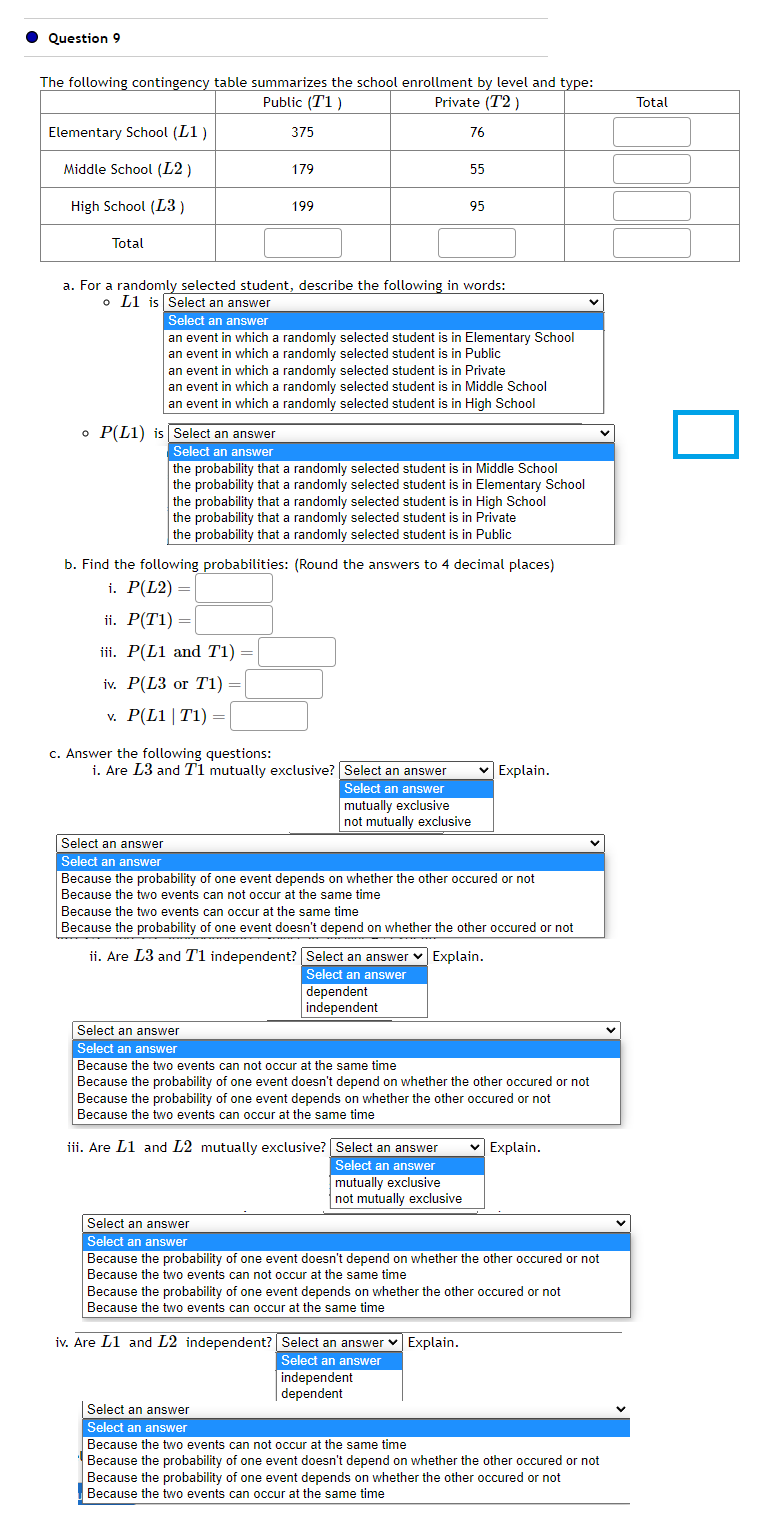contingency table summarizes the
Algebra & Trigonometry with Analytic Geometry
13th Edition
ISBN:9781133382119
Author:Swokowski
Publisher:Swokowski
Chapter10: Sequences, Series, And Probability
Section10.8: Probability
Problem 32E
Related questions
Question
100%
ANSWER EVERYTHING FOR UPVOTE

Transcribed Image Text:● Question 9
The following contingency table summarizes the school enrollment by level and type:
Public (11)
Private (T2)
Elementary School (L1)
Middle School (L2)
High School (L3)
Total
iv. P(L3 or T1) =
v. P(L1 | T1) =
375
c. Answer the following questions:
179
a. For a randomly selected student, describe the following in words:
o L1 is Select an answer
Select an answer
Select an answer
199
Select an answer
an event in which a randomly selected student is in Elementary School
an event in which a randomly selected student is i Public
an event in which a randomly selected student is in Private
an event in which a randomly selected student is in Middle School
an event in which a randomly selected student is in High School
o P(L1) is Select an answer
Select an answer
the probability that a randomly selected student is in Middle School
the probability that a randomly selected student is in Elementary School
the probability that a randomly selected student is in High School
the probability that a randomly selected student is in Private
the probability that a randomly selected student is in Public
b. Find the following probabilities: (Round the answers to 4 decimal places)
i. P(L2) =
ii. P(T1) =
iii. P(L1 and T1) =
=
i. Are L3 and T1 mutually exclusive?
Select an answer
Select an answer
76
55
95
iv. Are L1 and L2 independent?
Select an answer
Select an answer
mutually exclusive
not mutually exclusive
Because the probability of one event depends on whether the other occured or not
Because the two events can not occur at the same time
Because the two events can occur at the same time
Because the probability of one event doesn't depend on whether the other occured or not
ii. Are L3 and T1 independent?
dependent
independent
iii. Are L1 and L2 mutually exclusive? Select an answer
Select an answer
mutually exclusive
not mutually exclusive
Select an answer ✓ Explain.
Select an answer
Select an answer
Select an answer
Because the two events can not occur at the same time
Because the probability of one event doesn't depend on whether the other occured or not
Because the probability of one event depends on whether the other occured or not
Because the two events can occur at the same time
✓ Explain.
Select an answer ✓ Explain.
Select an answer
independent
dependent
Because the probability of one event doesn't depend on whether the other occured or not
Because the two events can not occur at the same time
Because the probability of one event depends on whether the other occured or not
Because the two events can occur at the same time
✓ Explain.
Select an answer
Select an answer
Because the two events can not occur at the same time
Because the probability of one event doesn't depend on whether the other occured or not
Because the probability of one event depends on whether the other occured or not
Because the two events can occur at the same time
Total
Expert Solution
This question has been solved!
Explore an expertly crafted, step-by-step solution for a thorough understanding of key concepts.
This is a popular solution!
Trending now
This is a popular solution!
Step by step
Solved in 2 steps with 2 images

Recommended textbooks for you

Algebra & Trigonometry with Analytic Geometry
Algebra
ISBN:
9781133382119
Author:
Swokowski
Publisher:
Cengage

Trigonometry (MindTap Course List)
Trigonometry
ISBN:
9781337278461
Author:
Ron Larson
Publisher:
Cengage Learning

Linear Algebra: A Modern Introduction
Algebra
ISBN:
9781285463247
Author:
David Poole
Publisher:
Cengage Learning

Algebra & Trigonometry with Analytic Geometry
Algebra
ISBN:
9781133382119
Author:
Swokowski
Publisher:
Cengage

Trigonometry (MindTap Course List)
Trigonometry
ISBN:
9781337278461
Author:
Ron Larson
Publisher:
Cengage Learning

Linear Algebra: A Modern Introduction
Algebra
ISBN:
9781285463247
Author:
David Poole
Publisher:
Cengage Learning